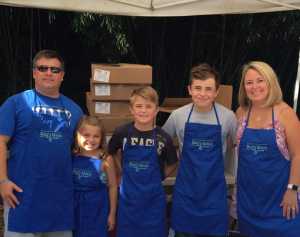
Everyone has heard the saying that each person is as unique as a snowflake. For Kristi and Matt Meyer of Max’s Meals & More, every cake they deliver to Cincinnati Children’s Hospital Medical Center (CCHMC) must be as unique as the child requesting it. Their non-profit organization partners with local Busken’s Bakery to create custom cakes for inpatient children at the hospital’s Cancer & Blood Diseases Institute (CBDI) for birthdays or any special occasion such as last day of chemo or transplant day. It’s a small gesture that lights up the lives of these children and their families in the biggest of ways.
Established in 2009, Max’s Meals & More (MMM) was founded in honor of Kristi and Matt’s son, Max. The organization strives to support families who spend all of their time, from days through nights, over weekends and holidays, for weeks, sometimes months, at CCHMC in the CBDI as their child undergoes treatment. The Meyers and their family know this experience all too well because Max received a lifesaving bone marrow transplant at the age of seven as part of his treatment for Aplastic Anemia, a rare bone marrow failure disorder. When Max was discharged from the hospital after eight long weeks, the Meyers wanted to help families they had come to know during their time in the hospital who were still there supporting their children, as well as families yet to undergo such a difficult circumstance. As Cincinnati natives, the Meyers were lucky to be surrounded by family and friends during this challenging process, but many families had travelled long distances, even overseas, so that their children could be treated at CCHMC/CBDI. Kristi began brainstorming ways in which they could support these families, and so Max’s Meals & More was born.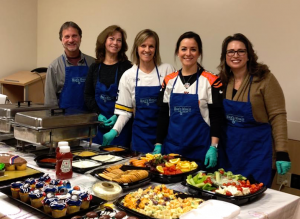
As evidenced by the name, MMM serves monthly meals, free of charge, to all CBDI families, including on major holidays, and hosts special events such as Spa Day and Super Bowl Sunday. Along with providing custom cakes to the children, MMM immediately answers personal requests of families and staff, whether it is a need for comfort items, special food requests, toys, personal care products or clothing, and holiday-specific or support activity supplies. To date, every request has been fulfilled. Remembering how it felt to finally leave the hospital, home at last but away from the watchful eyes of skilled doctors and nurses, Kristi also created take-home bags to give to discharged families to help them confidently care for their children. These “Helping Hands” bags include a flashlight for checking on their child at night, a thermometer, hand sanitizer, and much more.
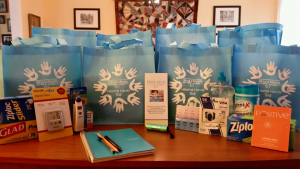 Their biggest event of the year, Kick Up Your Heels for Max’s Meals, will take place April 6th. Families from around Cincinnati will gather to dance, eat, play games, and raise money for an organization that has positively touched so many lives. Among them, Max, now sixteen, will laugh and chat with his friends like any other high school boy his age. All proceeds go directly to serve CBDI children and their families with meals, comfort items, and support activities with the hope that other children can overcome their diagnoses and start on the road to recovery. The evening will be filled with love, friendship, and laughter, and thanks to the Meyer family and Max’s Meals & More, it will continue to touch the lives of many even after the music fades.
Their biggest event of the year, Kick Up Your Heels for Max’s Meals, will take place April 6th. Families from around Cincinnati will gather to dance, eat, play games, and raise money for an organization that has positively touched so many lives. Among them, Max, now sixteen, will laugh and chat with his friends like any other high school boy his age. All proceeds go directly to serve CBDI children and their families with meals, comfort items, and support activities with the hope that other children can overcome their diagnoses and start on the road to recovery. The evening will be filled with love, friendship, and laughter, and thanks to the Meyer family and Max’s Meals & More, it will continue to touch the lives of many even after the music fades.
For more information on Max’s Meals, or if you are interested in volunteering or attending the fundraiser, please visit http://www.maxsmeals.org/.
]]>
The Positive 365 book of quotes helped me understand fully how we are all tethered together by a force greater than ourselves. Strangers told me stories about how the book made a difference in their lives or changed a relationship or uplifted someone they loved who needed to hear an encouraging word. I realized these people who read the book were no longer strangers. In fact I realized that there really aren’t any strangers. There are only people I don’t know well enough. Abe Lincoln’s quote, “I don’t like that fellow, I must get to know him better” resonates with me because of the positive personal reactions from people I didn’t know as they commented about the book.
I’m very excited to announce there is a new and improved version of the Positive 365. It’s called the Positive 366 – The Leap Year edition. This new book of 366 quotes is the result of a chance meeting with a friend of mine’s autistic son. As I handed him the book when it was published in 2012, he immediately told me the book was wrong. He read the cover and said, “There isn’t a quote for everyday because there are 366 days this year.” (2012 was a leap year.) We had a laugh about his perspective, but the thought stuck with me.
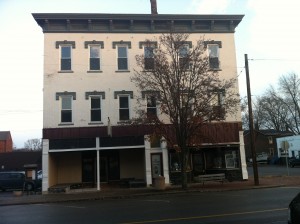
As I collected and organized these quotes for publication I was struck by what a difference they made in my thinking every time I read them. I laughed out loud at some and felt heart felt conviction in others. There is great collected wisdom in these condensed blurbs of reflective thought by some of humanity’s greatest minds.
I decided to whittle down the list to my absolute favorite quotes. The condensing of the quotes that resonated with me at my core taught me something about my mind and my attitude. I’ll let you jump to your own conclusions on what I learned from compiling this new group of quotes. Here are the quotes at the top of my list:
7) “If it can be solved, there is no need to worry, and if it can’t be solved, worry is of no use.” Dalai Lama
6) “Plenty of people miss their share of happiness, not because they never found it, but because they didn’t stop to enjoy it.” William Feather
5) “The cave you fear to enter holds the treasure that you seek.” Joseph Campbell
4) “We are not human beings having a spiritual experience, but spiritual beings having a human experience.” Teilhard de Chardin
3) “The melody of our authentic self is within all of us… if we will be still enough to hear our song and brave enough to dance our dance.” Sam Wilder
2) “I’ve become convinced that the things that matter most are the things that you can’t see — the love you share with others, your inner purpose, your comfort with who you are.” Jimmy Carter
1) “When we want to make another person happy we want to give them something. But the most precious thing you can give him or her is not something you buy from the market. It is your true presence.” Thich Nhat Hanh
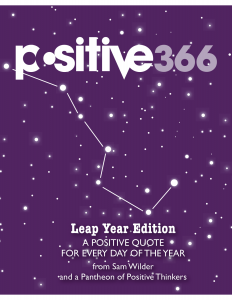
The all-new Positive 366 Leap year Book of Quotes is available on Amazon. These positive quotes delivered a positive thought to me in a meaningful way. My hope it is that reading this book is something you can’t not do! I know it’s a leap you won’t regret-
Here’s the link to the book on Amazon:
http://www.amazon.com/Positive-366-Sam-Wilder/dp/0692618872/ref=sr_1_1?ie=UTF8&qid=1459973503&sr=8-1&keywords=positive+366
]]>
Janet Rowley died in December, and I still wake up some mornings hoping I can still call her and invite myself to breakfast, anticipating a hug at the door and a bowl of homemade granola on the table. This is how it had been for the past seven years as I wrote her biography.
We would shuffle to the back of her house, to the solarium, which felt like a greenhouse even in the depths of winter. After catching up on where I was with the manuscript, I would ask about recent news—government spying, wars in Africa, new cancer research. I wanted Janet’s take on this complicated world, as she was a wildly intelligent, creative woman who could offer perspective. In more recent months, the conversation would wind back to her husband, the innovative pathologist and immunologist Donald Rowley, who passed away in February 2013.
With regard to some obstacle tackled in the kitchen or another mystery solved in the lab, she would say, “That’s just how he was—brilliant.” Janet always took the seat at the table right below his photos—two computer printouts taped to the wall. “Cheers,” we would say.
Janet was brilliant, too. Her CV stretches to nearly 60 pages and holds so many awards and honorary degrees that even after seven years as her biographer I can’t recall all of them. When Donald first brought her from Chicago to Minnesota to meet his parents in 1947, he told his father that Janet had one of the best minds he had ever encountered.
One day before their 65th wedding anniversary and 65 years to the day after graduating medical school, Janet passed away. She left behind hundreds of family members and friends, millions of people affected by her work, and a laboratory still fighting to answer questions she initiated 40 years ago.
I knew Janet through most of my 20s, and my work as a biographer positioned me to ask extremely intimate questions and witness what life meant to her. Here are five lessons I learned, which will stay with me for the rest of my life:
1). Don’t let age define what you accomplish.
Janet was undaunted by certain societal expectations. She relied on her intuition and personal experiences to make decisions, rather than pressure from outside influences. When Janet applied to medical school in 1943, the school had already filled its quota of three women per class. She waited nine months until the next available opening. Thirty years later, Janet made her first major discovery. Too often, she has lamented, people tend to fault themselves if they haven’t accomplished anything major by age 30. While other researchers let their self-perceived failures define them, Janet searched for patterns in chromosomes, leading to a discovery that translated into life-saving cancer treatment. Then, she kept at it. Janet was 50 before the broader scientific community accepted her work, 73 when she won the National Medal of Science, and 87 when she received the Japan Prize.
2). Be an informed participant in the world.
Janet was rallying against sequestration’s potentially “catastrophic effects” long before I began hearing the buzzword. That diligence came through in her professional life, too. On George W. Bush’s Bioethics Council in the early 2000s, Janet reviewed reports on everything from stem cell research to health insurance. But she would turn in her edits days after deadline. The first time it happened, Council Chairman Leon Kass said he was furious. However, he added, “She did her homework. She read everything line-by-line, page-by-page. The reports were made clearly better by her care.” So listen to NPR. Read The New York Times over breakfast. Keep the latest periodicals, from Nature to The New Yorker, close at hand. And do your homework.
3). Give the people closest to you enough space to make their own decisions.
This includes you. Janet said she always valued time in her garden, where she had many epiphanies. With space away from work, she could let her thoughts wander. Giving loved ones space may be more difficult, because it means letting go of control. At 19, Janet’s son Donnie moved across the country to Oregon, where he lived in a tree house, removed from society. She worried until she realized the worry might kill her. And what good was that? Janet knew she couldn’t do anything except be available when he needed her. She understood fiercely independent spirits, being one herself, and also seemed to believe that she couldn’t make someone do something they weren’t ready to do.
4). Have a glass of wine with dinner, but then get back to work.
You have to find something in life that you feel passionately about—enough to do it even after a long work day, even when you could zone out on the couch instead. Your passion itself might take immense effort, but doing it will energize you. Especially for people just starting out, Janet said, “You’re going to need patience.”
5). If you find a partner in life, support that person. (But support yourself, too.)
Janet did this for Donald, whether that meant taking care of their sons while he returned to the lab after dinner, or standing by him later in life when he mass-produced a table he had designed, or opening up when he commissioned me to write her biography. However, Donald brought Janet to tears while editing one of her papers after she discovered the second translocation in leukemia: She claimed the translocations were driving cancer; he wanted to know what was causing the translocations. But Janet believed in her theory. She pushed herself—first in the face of Donald’s challenge, and then in front of scientists worldwide. The way we think about and treat cancer today would be much different if she hadn’t.
]]>Why she gave this to me and not her other five children remains unclear. Perhaps she saw my disillusionment with the rat-a-tat, airless echo of school, the Catholic Church, the Sunday roast dinners and our predictable life. I had been punished a number of times for staring out the school window day-dreaming about who knows what, maybe stink bugs. Then came the thwack of the ruler, held by a tight-fisted, chalky nun who sent me off to kneel on the concrete hallway floor for two hours. I would later go home and draw pictures of nuns being kidnapped, held in dark closets, being starved, begging for mercy. I hid the stories under my bed, accompanying the other stacks, all concerning some level of inequality.
During this time, music and freedom called my mother to another place, a more hopeful existence where she wouldn’t be a “wife.” She was a hippy to my father’s buttoned-up businessman. My mother did not have many heroes, as they were fleeting and then dead: Malcolm X, Martin Luther King Jr. and the Kennedys. But there was something about Einstein that settled into her very core, then mine.
A new life began and I took Albert along as a companion
In 1969, she had had enough. She confided in me: “We are leaving. Tell no one; your sisters won’t understand. Your father will return to an empty house, to complement his empty existence.”
Then: “Imagination is more important than knowledge. Don’t forget that. Ever.”
Thus began my own obsession with Einstein. I tucked these quotes into my grandmother’s jewelry box, which she had given me just prior to her death.
Legions of people remain enamored by this brilliant man, not just for what he discovered, accomplished and how he radically changed the world, but because of his childlike innocence, his unlimited curiosity, great humility, a legacy of words that continue to endure. When you ask a complete stranger who defines genius, they might reply, “Oh, Einstein.”
And he was a rascal, with wild eyes, the mop of hair, his crumpled clothes. This made him real for the rest of us. I began to collect quotes and read about him in libraries. His humor brought me great comfort. He wasn’t some impervious man one couldn’t access. He didn’t believe in separating himself from others, and in fact loved sharing his ideas, while helping others expand on their own. He was approachable, both alive and dead.
Born with a kind of eternal intelligence, his curiosity about all things began to emerge at age four. While examining his father’s pocket compass, Einstein was baffled. What was causing the needle to move? The empty space made no sense to him. He began to build models and mechanical devices for fun. He wanted answers. Age 10, he met Max Talmey, a poor, Jewish medical student from Poland, who introduced him to science, math, philosophy, Immanuel Kant’s Critique of Pure Reason and Euclid’s Elements, which Einstein dubbed “the holy little geometry book.”
He was brilliant in his own way
As a boy, his father knew little Albert was gifted, and perhaps because the elder Einstein (an engineer) had failed at so many businesses, he insisted his son stay in school. He enrolled him in a school in Munich to pursue engineering, but Albert was frustrated with the educational system. He clashed repeatedly with the authorities, resented their teaching style and wrote about how schools were essentially killing the creative spirit and curiosity of its students. He was 15.
“The only thing that interferes with my learning is my education.” When I read this in junior high school, I could finally relax. The simple statement brought along a universe of vindication because I simply could not understand the entire educational process of rote learning. It was too boxed in, too impersonal. I realized I would have to find my own way intellectually alongside the traditional, through books and lectures by Rollo May, Erich Fromm, B.F. Skinner, Timothy Leary and Marshall McLuhan.
I was no genius, simply curious and bored with school. Given the number of times my gypsy mother moved us, staying on track in class made me weary. Another school, another teacher, another set of young people I would have to navigate somehow.
Why has Einstein resonated so deeply with me and so many others? Among the world’s most brilliant minds, he continues to inspire. What of da Vinci, Tesla, Newton, Hawking, Aristotle, Edison, Cervantes? The list goes on. They too share not just powerful minds, but an endless pursuit through curiosity and instinct. They knew knowledge was important, had to be learned, but could only get them so far. The rest is mystery.
Einstein embodies the mystery. So many of his ideas, beyond his incredible discoveries in the world itself, which ultimately turned the world on its head, contain room, empty space, air to breathe. His equation, E = mc2, may be the most famous equation in physics, eventually setting the stage for the development of the atomic bomb and nuclear power plants. But had he known where this was going, he said, he should have become a watchmaker.
To this day, his theories inspire advances in science, astronomy and physics, as well as from philosophers. I keep a tip sheet of quotes tacked up near my computer and read one every day. It really doesn’t matter which one, as they all carry great meaning. With each read I come away with yet another interpretation.
Einstein would go on to fail countless exams when applying to higher learning institutions. Yet, he continued exploring, reading and taking great interest in other’s concepts and ideas. He did eventually get accepted into the Polytechnic in Zurich. He wanted more knowledge and continued developing his own theories and expanding others.
His instincts propelled him yet further
He never lost his ability to stay curious, intuitive and of course, humorous. Despite his apparent genius, upon graduation he could not get a job and landed at the patent office, only to be overlooked for a promotion because he had not managed to grasp machine technology. But it was there that the 26-year-old developed further radical notions in his spare time by analyzing various patents. And he never stopped writing about his findings.
Finally, with some recognition, he left the patent office, and by 1908 was considered as one of the world’s leading scientists. He went on to become a professor in Prague and Berlin, and ultimately became famous a few years later when his theory of relativity at last made a permanent impression on the world. Ten years later, he was awarded the Nobel Prize in Physics.
For many years after, he traveled the globe, lecturing. “Of all the people I have met, I like the Japanese the most, as they are modest, intelligent, considerate, and have a feel for art,” he wrote to one of his sons. This is the statement that captures the man himself. He maintained his own humility until the day he died. He was a genius, but also a gentleman, a humorist, altruist, artist and a great believer in love. “How on earth are you ever going to explain in terms of chemistry and physics so important a biological phenomenon as first love?”
The entire universe was Einstein’s canvas, and he made this world relatable to all of us. I’ve been to my fair share of enlightenment lectures, often given by physicists turned “gurus,” and there they sit, spouting what I had already learned by Einstein’s words:
“Anyone who has never made a mistake has never tried anything new.”
“Great spirits have often encountered violent opposition from weak minds.”
“We can’t solve problems by using the same kind of thinking we used when we created them.”
And of course, perhaps the most famous, his definition of insanity: “Doing the same thing over and over again and expecting different results.”
Meanwhile, back in New Jersey
Of all the great brains, his would be the one cut into 240 pieces, kept in jars, cardboard boxes, often hidden, studied under microscopes. Bits of his grey matter still remain at Princeton University. All those years of cutting, probing and analyzing amounted to little new knowledge of the human mind.
The contradiction rattles the very jars into a pulpy mess, if only because it contradicts what Einstein tried to impress. Stay curious and questioning; love the mystery. Conventional knowledge, though essential, is finite. Imagination is not. This is what Einstein embraced. Perhaps the lore of his brain in a jar helps prolong the iconic myth. In his words: “The most beautiful thing we can experience is the mysterious. It is the source of all true art and all science. He to whom this emotion is a stranger, who can no longer pause to wonder and strand rapt in awe, is as good as dead: his eyes are closed.”
Recently, while driving my own eight-year-old girls to school, I said, “Remember, imagination is more important than knowledge.”
Through the rear view mirror, I watched them both roll their eyes in that “Please mom, just drive,” kind of way, as they said in unison, “OK, Einstein.”
]]>